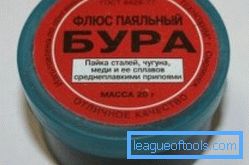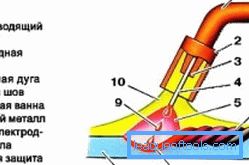How can brazing be made with high quality?
Brass is widespread in everyday life, and the question of how to solder brass is very important for some. Repair of many household devices depends on how to solder the metal. This process is markedly different from the combination of other metals. It has a number of specific features and causes certain difficulties. However, if you fulfill some conditions, then the ration will be on the shoulder to any person.

Brass is widely used in everyday life, and when brass products break, the question arises of how to solder it.
Features of copper alloy soldering
In everyday life often used different parts that use brass and bronze. These copper alloys are outwardly very similar, but have a different composition and their own characteristics. Brass is a copper-zinc alloy with the addition of tin, aluminum and other metals. Bronze is an alloy of copper with tin, aluminum, lead and other substances. Brass, in which tin is added, approaches the composition of bronze, but nevertheless it is based on zinc.

Materials and tools for brazing brass products.
Brass brazing has its own characteristic difficulties. Zinc is actively evaporated by heat from the alloy, forming a dense film of zinc oxide and copper. The film of zinc oxide is destroyed with great difficulty, and its formation when the zinc content in brass is more than 15% occurs fairly quickly. Rosin, even in combination with alcohol, cannot cope with such a film, which requires the use of special fluxes.
If tin-lead solder is used when brazing brass, the joint has low mechanical strength. So, the place of soldering of brass with tin-lead solder has strength 1.6 times less than that of copper. This is due to the appearance of pores in the solder seam due to the evaporation of zinc.
Methods of soldering bronze depend on its composition. Tin and nickel bronzes are easily soldered with tin-lead solders. When soldering aluminum and beryllium bronzes, difficult-to-dissolve films appear, which necessitates the use of special solders and fluxes.
Back to table of contentsFluxes for soldering metals

To solder brass you need a drill - a special flux.
Fluxes are designed to remove the film from the surface of soldered metals and protect against the formation of new films in the soldering zone. If rosin is quite enough for a copper compound, then another, much more aggressive flux is needed for brass. The composition of the flux for different brass need different, which is caused by the introduction of the composition of the brass of some metals. For common brass type LS59 and L63, the use of zinc chloride with a small content of boric acid is sufficient. When brazing with lead and silicon additives, for example, brass type LKS80, flux based on a combination of potassium with fluorine and boron or on the basis of borax is recommended.
At home, you can make the following flux, which is suitable for most brass. It is necessary to prepare 20 g of borax in powder and 20 g of boric acid in powder. Dry powders mix well and pour 200 ml of water. The mixture is then boiled and cooled.
From the finished compositions as fluxes for brass, we can recommend: domestic - flux "Bura"; fluxes PW-209 and PW-209X. From imported fluxes should be noted German-made: flux-paste Chemet FLISIL-NS-Pulver and Chemet FLISIL-NS-Paste.
Bronze soldering is possible to carry out under a flux of chloride salts (for example, zinc) with the addition of hydrochloric acid. If brazing is performed at high temperatures, then it is better to use boric acid in combination with chlorates and fluorides. To connect aluminum and manganese bronzes, it is necessary to use active fluxes from phosphoric or hydrofluoric acid. Of the sufficiently available funds, orthophosphoric acid is commonly used.
Back to table of contentsBrass solder

Solder brass should be copper-phosphorous. solder
Solder is a metal that, in the molten state, is embedded in the brazed metals and, after cooling, joins them. Therefore, it must have a melting point well below the melting point of brass and at the same time have good adhesion with it, being in the form of a melt. Conventional alloys of tin with lead should be used in brass only when joining non-critical parts where there are no requirements for mechanical strength and appearance.
The composition of the solder used depends on the type of brass. If the copper component is predominant in brass, then you can use silver solders from PSr12 to PSr72, solders with brass content from PMC36 to PMC54 and copper-phosphorous solders. In case of predominance of zinc content, silver solder should be used not lower than PSr40. The use of phosphorous compounds leads to a marked decrease in the mechanical strength of the compound due to the formation of fragile phosphate zinc compounds. Cheaper solders based on brass type PMC can only be used in parts that do not feel vibration and shock. When combined with silver and phosphorous solders, brass dissolves quite strongly, which should be taken into account, and reduce the time of soldering and heating of metals.
For the repair and connection of fixed parts (for example, radiators or pipes), special hard solders with complex composition are often used. Good results show solder type L-CuP6, having a melting point of about 730 ° C.
Back to table of contents
DIY Solder Cooking

Silver solder is also suitable for packs of brass.
In order to solve the problem of brazing brass, you should prepare the desired solder with your own hands. Silver solder is the most suitable for all brass; and it should be cooked. Melting of metals should be carried out in a crucible that can withstand significant thermal effects. Most simply such a crucible is made of contact coal elements for trolley buses. Burnt items are readily available and may come in handy for a crucible. In such a graphite element, a notch of about 2x2 cm is made, and a notch with a width of about 5 mm is cut through to the notch (to facilitate the removal of solder).
Silver and copper are necessary for solder in a ratio of 2: 1. The required amount of metals is measured and lowered into the crucible. With the help of a gas torch, melting of metals in the crucible is achieved. To simplify the process of melting, the metals should be crushed beforehand. The melt is mixed with a steel or ceramic (porcelain) core. After cooling, such an alloy can be used as a solder.
Back to table of contentsSoldering iron

Soldering iron for brazing brass must be at least 100 watts.
Sufficiently high quality of the connection by the method of low-temperature soldering is achieved by brazing brass and copper or by brazing with a predominance of copper content in them. In this case, it is enough to use a 100W soldering iron. Soldering or phosphoric acid can be used as a flux. Before soldering, it is necessary to thoroughly treat the surface of brass to remove the oxide film and degrease the surface. Tin-lead solder not lower than POS60 is used as solder. Soldering is performed with good heating with a soldering iron of the soldering zone.
You can also solder brass with a soldering iron using silver solders not lower than PS40. For this, you will have to arm yourself with a powerful soldering iron (0.5-1 kW). Concentrated orthophosphoric acid or borax based flux should be used as a flux. The heating temperature of the soldering zone should be not lower than 500ºС. Before soldering, special attention should be paid to the thoroughness of flux surface treatment. Processing should be carried out immediately before the submission of the heated soldering iron with solder. In this way, you can melt defects in brass massive products (for example, radiators).
Back to table of contentsBurner soldering

Scheme of welding brass semi-automatic torch.
To solve the problem of soldering brass of any brand, you can use a gas burner. The process of such soldering is as follows. The soldering (warming up of metals) is made on heat-resistant material. It is best to use an asbestos plate. The connected parts are placed on an asbestos base and are combined with each other. The surface of the metals in the zone of the compound is thoroughly rubbed with a borax based (self-made) flux.
Silver solder is cut in the form of small chips and sprinkles on top of the joined metals in small quantities. The regulated flame of a gas torch is introduced into the soldering zone. Warming up is performed in stages.
Initially, a light warm-up of the area is carried out so that the solder clutches with the surface of the metals.
Then, the main heating is performed until the appearance of red on the brass. At this time, the solder should fill the gap between the parts and spread evenly over the surface. The temperature in the soldering zone during this period reaches 700-750 ° C. The burner turns off. After cooling, you should get a reliable seam with a color that differs little from brass. The junction must be flushed to remove residual flux.
Back to table of contentsNecessary tool
If you decide what to solder, then you should also decide the question of what to cook. When brazing brass you will need the following tools and accessories:
- 100 W and 0.5-1 kW soldering iron;
- gas burner complete with gas cylinder;
- crucible;
- Libra;
- vice;
- knife;
- scissors;
- file;
- pliers;
- clamp;
- emery sandpaper;
- tassel;
- brush.
Brass is very often used in various household devices, so when they break, the question arises as to how to solder brass. Such a ration is quite possible, but requires the fulfillment of certain conditions and rules.